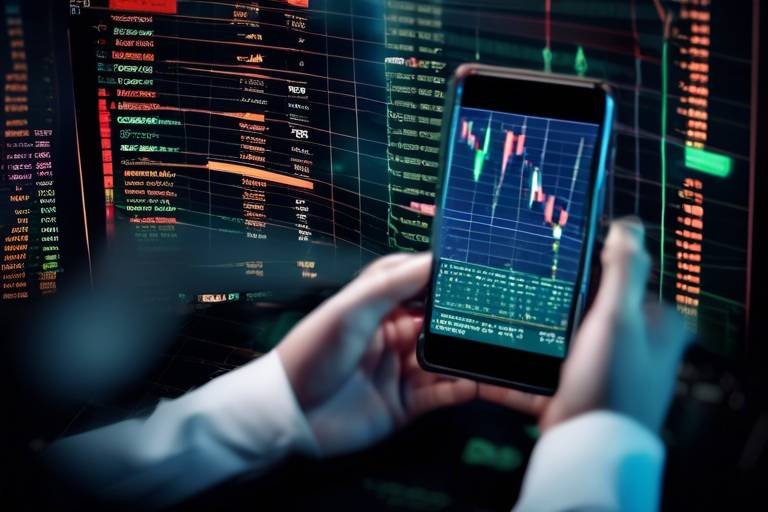How to Handle Losing Trades in Cryptocurrency
In the fast-paced world of cryptocurrency trading, losing trades can feel like a punch to the gut. It's not just about the money; it's about the emotional rollercoaster that comes with it. But fear not! This article dives deep into effective strategies for managing those losing trades. We'll explore how to cultivate emotional resilience, implement robust risk management techniques, and learn from our mistakes to enhance our trading outcomes. So, buckle up as we navigate this tumultuous journey together.
Let’s face it—losing trades can evoke a whirlwind of emotions. Fear, frustration, and even regret can cloud your judgment, making it difficult to think clearly. It's like being stuck in a storm without a compass. Recognizing these feelings is the first step to maintaining a clear mindset. You might ask yourself, "How can I keep my cool when everything feels like it's falling apart?" The answer lies in acknowledging your emotions without letting them dictate your decisions. By practicing mindfulness and emotional awareness, you can create a buffer against the chaos of the market.
When it comes to trading, **risk management** is your best friend. Think of it as your safety net, designed to catch you before you hit rock bottom. Implementing effective risk management techniques is crucial for minimizing losses. One of the most powerful tools in your arsenal is the stop-loss order. This order automatically sells your asset when it reaches a certain price, helping you limit potential losses. But that's just the tip of the iceberg. Let’s break down some essential strategies that every trader should consider:
A stop-loss order is more than just a safety net; it's a critical tool for limiting potential losses. But how do you effectively set these levels? The key is to align your stop-loss with your trading strategy and the inherent volatility of the market. For instance, if you’re trading a particularly volatile cryptocurrency, you might want to set a wider stop-loss to avoid being prematurely kicked out of a trade. On the other hand, for more stable assets, a tighter stop-loss could be more appropriate. Understanding this balance is crucial for protecting your capital.
Choosing the right stop-loss level is like finding the sweet spot in a game of darts. It requires analyzing market trends and understanding your personal risk tolerance. You can start by looking at historical price movements and determining key support and resistance levels. For instance, if a cryptocurrency has consistently bounced back at a certain price point, setting your stop-loss just below that level could be a wise move. Remember, it’s not just about the numbers; it’s about feeling comfortable with your risk.
As market conditions change, so should your stop-loss orders. Think of it as steering a ship; you wouldn’t keep the same course if a storm is brewing. Regularly adjusting your stop-loss levels allows you to adapt to new information and market dynamics. For example, if a cryptocurrency starts to gain momentum and breaks through a resistance level, you might want to adjust your stop-loss upwards to lock in profits. Staying flexible is key!
Diversification can be a game-changer when it comes to mitigating the impact of losing trades. Imagine you’re at a buffet; if you only fill your plate with one dish and it turns out to be terrible, you’re left hungry. However, if you sample a variety of dishes, you’re more likely to find something you enjoy. In trading, spreading your investments across various assets can reduce overall risk and enhance portfolio stability. This way, a loss in one area can be offset by gains in another.
Every losing trade presents a golden opportunity for growth. It’s like stumbling upon a hidden treasure map; the insights you gain can lead you to success in future trades. Analyzing past trades helps identify patterns, mistakes, and areas for improvement in your trading strategies. Instead of wallowing in regret, ask yourself, "What can I learn from this?" This mindset shift is crucial for long-term success.
Maintaining a trading journal is a valuable practice for reflecting on your trades. It's like having a personal coach by your side, guiding you through your successes and failures. Documenting your decisions and outcomes can lead to better trading discipline and insights. You can analyze what worked, what didn’t, and why. Over time, this journal will become an invaluable resource for refining your strategies and enhancing your trading skills.
Sometimes, we all need a little help. Seeking advice from experienced traders or mentors can provide new perspectives that you might not have considered. Think of it as having a seasoned navigator on your trading journey. Professional guidance can enhance your trading skills and decision-making process, giving you the confidence to tackle the markets head-on.
- What should I do immediately after a losing trade?
Take a moment to breathe, assess your emotions, and analyze what went wrong. Avoid making impulsive decisions. - How can I improve my emotional resilience?
Practice mindfulness, stay informed about market trends, and develop a solid trading plan. - Is it necessary to have a trading journal?
Yes! A trading journal helps you reflect on your trades and learn from your experiences. - How often should I adjust my stop-loss orders?
Regularly! Adjust your stop-loss orders based on market conditions and your trading strategy.

Understanding the Emotional Impact
This article explores effective strategies for managing losing trades in cryptocurrency, offering insights on emotional resilience, risk management, and learning from mistakes to improve future trading outcomes.
Losing trades in cryptocurrency can hit you like a ton of bricks. Imagine investing your hard-earned money, only to watch it evaporate before your eyes. It's not just about the money; it's about the emotional rollercoaster that comes with it. Feelings of fear, frustration, and even shame can cloud your judgment, making it difficult to make rational decisions in the heat of the moment. Recognizing these emotions is the first step toward maintaining a clear mindset.
Think of it this way: trading is like a game of chess. Each move counts, and losing a piece can be disheartening. However, just like in chess, you must learn to adapt and think several moves ahead. When you experience a losing trade, it's vital to take a step back and assess the situation without letting your emotions dictate your next move. Ask yourself: What went wrong? Was it a poor strategy or just bad luck? By reflecting on these questions, you can begin to untangle the emotional mess and focus on the facts.
It's also important to recognize that you're not alone in this journey. Many traders face similar challenges, and sharing your experiences can be cathartic. Consider joining online forums or local trading groups where you can discuss your struggles and learn from others. This sense of community can help you feel less isolated and provide valuable insights into how others navigate their emotional responses to losing trades.
In summary, understanding the emotional impact of losing trades is crucial for any cryptocurrency trader. By acknowledging your feelings and taking proactive steps to manage them, you can improve your trading mindset and decision-making skills. Remember, every trader has faced losses; it's how you respond that truly matters.
Implementing risk management techniques is crucial for minimizing losses. This section discusses various strategies, including stop-loss orders and position sizing, to protect your capital during unfavorable market conditions.
A stop-loss order is a critical tool for limiting potential losses. This subsection explains how to effectively set stop-loss levels based on your trading strategy and market volatility.
Choosing the right stop-loss level requires analyzing market trends and personal risk tolerance. This part delves into methods for determining optimal stop-loss placements to safeguard investments.
As market conditions change, adjusting stop-loss orders becomes essential. This section covers strategies for modifying stop-loss levels to adapt to new information and market dynamics.
Diversification can mitigate the impact of losing trades. This subsection outlines how spreading investments across various assets can reduce overall risk and enhance portfolio stability.
Every losing trade presents an opportunity for growth. This section emphasizes the importance of analyzing past trades to identify patterns, mistakes, and areas for improvement in trading strategies.
Maintaining a trading journal is a valuable practice for reflecting on trades. This part discusses how documenting decisions and outcomes can lead to better trading discipline and insights.
Sometimes, seeking advice from experienced traders or mentors can provide new perspectives. This subsection explores how professional guidance can enhance your trading skills and decision-making process.
- What should I do after a losing trade?
Take a moment to assess what went wrong and learn from your mistakes. It's essential to avoid making impulsive decisions based on emotions. - How can I manage my emotions while trading?
Practicing mindfulness, setting clear trading goals, and maintaining a trading journal can help you stay grounded and focused. - Is it normal to feel upset after losing trades?
Yes, it's completely normal. Acknowledging your feelings is the first step toward managing them effectively.

Risk Management Strategies
When it comes to trading in the volatile world of cryptocurrency, having a robust risk management strategy is not just a good idea—it's essential. The unpredictability of the market can lead to significant losses if you're not prepared. Think of it like sailing in stormy seas; without a sturdy ship and a well-thought-out plan, you risk capsizing. To navigate these turbulent waters effectively, you need to implement several key strategies that can help protect your capital and minimize losses.
One of the most effective tools in your risk management arsenal is the use of stop-loss orders. These orders automatically sell your cryptocurrency when it reaches a predetermined price, helping to limit your losses. Imagine you're on a rollercoaster ride, and you know there’s a steep drop ahead. A stop-loss order acts as your safety harness, preventing you from plummeting into despair when the market takes a downturn. Setting these orders requires careful consideration of your trading strategy and the inherent volatility of the market.
Another crucial aspect of risk management is position sizing. This means determining how much of your capital to allocate to each trade. If you invest too heavily in a single trade, a small market dip can wipe out a significant portion of your portfolio. On the flip side, if you invest too little, you may not see enough return to make the trade worthwhile. A good rule of thumb is to risk only a small percentage of your total capital on any single trade—typically around 1-2%. This way, even if a few trades go south, your overall portfolio remains intact.
To illustrate these concepts, consider the following table that summarizes key risk management strategies:
| Strategy | Description |
|---|---|
| Stop-Loss Orders | Automatically sell assets at a specified price to limit losses. |
| Position Sizing | Determining the amount of capital to risk on each trade. |
| Diversification | Spreading investments across different assets to reduce risk. |
Moreover, diversification is another effective strategy to mitigate risk. By spreading your investments across various cryptocurrencies, you can reduce the impact of a single asset's poor performance. Think of it as not putting all your eggs in one basket. If one cryptocurrency takes a nosedive, the others in your portfolio may still hold their ground or even increase in value, balancing out your overall risk. This way, even if you encounter a losing trade, your diversified portfolio can help cushion the blow.
In conclusion, mastering risk management strategies is vital for any cryptocurrency trader looking to navigate the unpredictable market successfully. By utilizing stop-loss orders, carefully sizing your positions, and diversifying your investments, you can protect your capital and enhance your chances of long-term success. Remember, the goal isn't just to survive the storm but to emerge stronger and wiser on the other side.
- What is a stop-loss order? A stop-loss order is a type of order that automatically sells your cryptocurrency when it reaches a specified price, helping to limit your losses.
- How much of my capital should I risk on a single trade? It's generally recommended to risk only 1-2% of your total capital on any single trade to minimize potential losses.
- Why is diversification important in cryptocurrency trading? Diversification helps to spread risk across multiple assets, reducing the impact of a poor-performing investment on your overall portfolio.

Setting Stop-Loss Orders
When diving into the world of cryptocurrency trading, one of the most effective tools at your disposal is the stop-loss order. This nifty feature acts like a safety net, designed to limit potential losses in your trading endeavors. Imagine you’re at a carnival, and you’re on a roller coaster. As thrilling as the ride is, you wouldn’t want to fly off the tracks, right? That’s exactly where a stop-loss order comes in; it keeps you grounded when the market takes a nosedive.
To set a stop-loss order effectively, it’s essential to first understand your trading strategy and the market conditions. You wouldn’t want to place a stop-loss order on a whim; instead, it should be a calculated decision based on your analysis. The key is to determine a price point at which you’re willing to exit a trade to prevent further losses. This price point is often dictated by your risk tolerance and the volatility of the cryptocurrency you’re trading.
For instance, if you bought a cryptocurrency at $100 and decide that you’re willing to risk a 10% loss, you would set your stop-loss order at $90. This means if the price drops to $90, your order will trigger, and you’ll exit the trade, minimizing your losses. However, it’s crucial to evaluate the market trends and the asset's historical price movements before setting this level. Analyzing support and resistance levels can provide insight into where to place your stop-loss.
Here are a few strategies to consider when setting your stop-loss levels:
- Percentage-Based Stop-Loss: This method involves setting your stop-loss at a specific percentage below the purchase price. It’s straightforward and allows for easy calculations.
- Support Level Stop-Loss: Placing your stop-loss just below a significant support level can be beneficial, as it allows for some fluctuations while protecting against larger downturns.
- Volatility-Based Stop-Loss: Using indicators like the Average True Range (ATR) can help determine a stop-loss level based on the asset's volatility, providing a more dynamic approach.
Once you’ve set your stop-loss order, it’s not set in stone. Just like adjusting your seatbelt on that roller coaster for added safety, you may need to adjust your stop-loss order as market conditions change. If the price of your cryptocurrency rises significantly, consider moving your stop-loss level up to lock in profits. This practice, often referred to as a trailing stop-loss, allows you to benefit from upward trends while still protecting yourself from potential downturns.
In conclusion, setting stop-loss orders is a fundamental aspect of trading that cannot be overlooked. It’s not just about preventing losses; it’s about maintaining control over your trading journey. By understanding how to set and adjust stop-loss orders effectively, you’re not just protecting your capital but also paving the way for more informed and strategic trading decisions in the future.

Determining Stop-Loss Levels
When it comes to trading cryptocurrencies, setting the right stop-loss level is akin to putting on a seatbelt before hitting the road. It’s a safety measure that can save you from catastrophic losses. But how do you determine that sweet spot for your stop-loss? First, it’s crucial to understand that there isn’t a one-size-fits-all answer; it largely depends on your trading strategy, market conditions, and personal risk tolerance.
One effective way to determine stop-loss levels is by analyzing recent price action and volatility. For instance, if you notice that a particular cryptocurrency tends to fluctuate within a certain range, you can set your stop-loss just below a recent support level. This approach not only protects your investment but also allows for normal market fluctuations. Think of it like giving your trade a little breathing room. However, if you set it too far away, you might end up losing more than you bargained for.
Another method involves using technical indicators, such as the Average True Range (ATR), which measures market volatility. By calculating the ATR, you can set your stop-loss a certain multiple away from your entry point. For example, if the ATR is $2 and you decide to set your stop-loss at 1.5 times the ATR, you would place it $3 below your entry price. This method adjusts your stop-loss based on how volatile the market is, making it a dynamic strategy.
To further illustrate, let’s consider a hypothetical scenario:
| Trade Entry Price | ATR Value | Stop-Loss Level (1.5x ATR) |
|---|---|---|
| $50 | $2 | $48 |
| $100 | $5 | $92.5 |
| $200 | $10 | $185 |
In this table, you can see how different entry prices and ATR values yield different stop-loss levels. This method helps you stay consistent and objective in your trading decisions.
Lastly, don’t forget to factor in your personal risk tolerance. If you’re someone who can’t stomach high volatility, you might want to set tighter stop-loss levels. On the other hand, if you have a higher risk appetite, you might be comfortable with wider stop-loss levels. Always remember that trading is not just about numbers; it’s also about your emotional capacity to handle losses.
In summary, determining stop-loss levels is a blend of market analysis, technical indicators, and personal risk assessment. By carefully considering these factors, you can set stop-loss levels that not only protect your capital but also align with your trading strategy. So, before you dive into your next trade, take a moment to evaluate these elements. It could make all the difference!
- What is a stop-loss order? A stop-loss order is an instruction to sell a security when it reaches a certain price, helping to limit potential losses.
- How do I know where to set my stop-loss? Analyze recent price trends, use technical indicators like ATR, and consider your risk tolerance to determine optimal stop-loss levels.
- Can I adjust my stop-loss after setting it? Yes, as market conditions change, it’s essential to adjust your stop-loss to protect your investment effectively.
- What happens if my stop-loss is triggered? If your stop-loss is triggered, your order will execute at the next available market price, which may be lower than your set stop-loss price in volatile markets.

Adjusting Stop-Loss Orders
In the fast-paced world of cryptocurrency trading, is not just a good practice; it’s a necessity. Market conditions can shift in the blink of an eye, and what might have been a safe investment one moment can turn into a potential loss the next. So, how do you effectively adjust your stop-loss orders to stay ahead?
First, it’s crucial to monitor the market trends continuously. This means keeping an eye on price movements, trading volume, and news that could impact your assets. For instance, if you’ve set a stop-loss at a certain percentage below your entry price, and the market begins to show signs of weakness, it might be wise to tighten that stop-loss. By doing so, you can lock in profits and minimize potential losses. Think of it like a safety net that you can adjust as you walk the tightrope of trading.
Moreover, consider the volatility of the asset you’re trading. In a highly volatile market, a stop-loss set too close to the current price may trigger unnecessarily due to normal price fluctuations. Therefore, understanding the typical price movements of your cryptocurrency can help you determine the optimal distance for your stop-loss. You wouldn’t want to pull the parachute too soon, right? Adjusting your stop-loss based on volatility allows you to give your trades some breathing room while still protecting your capital.
Another effective strategy is to use a trailing stop-loss. This type of stop-loss moves with the market price, allowing you to capture more gains while still maintaining a protective buffer. For example, if you set a trailing stop-loss at 5%, and the price of your cryptocurrency rises, your stop-loss will also rise, maintaining that 5% distance. This method can be particularly useful in trending markets where prices are moving upward consistently.
It’s also essential to remain emotionally detached when adjusting your stop-loss orders. Fear and greed can cloud your judgment, leading to impulsive decisions. Instead, base your adjustments on data and analysis rather than emotion. Keeping a clear head can be the difference between a successful trade and a regrettable loss.
Lastly, always remember to review your stop-loss strategy after each trade. Ask yourself: Did my adjustments work? What could I have done differently? This reflective practice not only enhances your skills but also builds your confidence as a trader. After all, every adjustment you make is a step towards mastering the art of trading.
- What is a stop-loss order? A stop-loss order is a trading tool that automatically sells your asset when it reaches a certain price, helping to limit potential losses.
- How often should I adjust my stop-loss orders? You should adjust your stop-loss orders as market conditions change, ideally after significant price movements or news events.
- What is a trailing stop-loss? A trailing stop-loss is a dynamic stop-loss that moves with the market price, allowing you to lock in profits while protecting against losses.
- Can emotional factors affect my stop-loss decisions? Yes, emotions like fear and greed can lead to poor decisions. It's important to rely on data and analysis instead.

Diversification Techniques
Diversification is like spreading your bets at a casino; instead of putting all your chips on one number, you distribute them across several options to increase your chances of winning. In the realm of cryptocurrency, this technique is not just a smart move but a vital strategy for managing risk and enhancing your overall portfolio stability. By diversifying your investments, you can cushion the blow of losing trades and potentially capitalize on various market movements. But how exactly can you achieve effective diversification in your crypto investments?
First and foremost, it’s crucial to understand that diversification isn't merely about holding multiple cryptocurrencies. It involves a strategic approach to selecting assets that behave differently under various market conditions. For instance, while Bitcoin might soar during a bullish trend, altcoins like Ethereum or Litecoin could react differently, providing a balance to your portfolio. This way, when one asset dips, another might rise, helping to offset potential losses.
One effective way to diversify is by investing in a mix of established cryptocurrencies and newer, emerging coins. Established coins often have more stability, while newer coins can offer higher growth potential. However, it's essential to conduct thorough research on these assets. A well-rounded portfolio might look something like this:
| Type of Asset | Examples | Risk Level |
|---|---|---|
| Established Cryptocurrencies | Bitcoin, Ethereum | Low to Medium |
| Emerging Altcoins | Chainlink, Polkadot | Medium to High |
| Stablecoins | USDT, USDC | Low |
In addition to asset selection, consider diversifying across different sectors within the cryptocurrency space. For example, you might invest in:
- Decentralized Finance (DeFi) projects
- Non-Fungible Tokens (NFTs)
- Blockchain technology companies
This approach not only helps to mitigate risks but also allows you to tap into various growth opportunities. Remember, the key to successful diversification lies in your ability to remain informed and adaptable. Monitor market trends and be ready to adjust your portfolio as needed. This might mean reallocating funds from underperforming assets to those showing promise or even exploring new sectors as they emerge.
Ultimately, diversification in cryptocurrency is about balancing risk and reward. While it’s impossible to eliminate losses entirely, a well-diversified portfolio can help you weather the storm of losing trades and provide a pathway to long-term success. So, as you navigate the volatile waters of cryptocurrency trading, keep diversification at the forefront of your strategy—it's your life raft in the unpredictable sea of digital assets.

Learning from Mistakes
Every losing trade presents an opportunity for growth. It's like stumbling while running a marathon; instead of wallowing in self-pity, you can use that experience to adjust your pace and improve your strategy for the next leg of the race. When you experience a loss in cryptocurrency trading, it’s crucial to shift your focus from the loss itself to the valuable lessons that can be extracted from the situation. This mindset shift is not just about avoiding the pain of loss; it’s about turning that pain into a stepping stone for future success.
Analyzing past trades is an essential step in this learning process. By taking the time to dissect what went wrong, you can identify patterns, mistakes, and areas for improvement in your trading strategies. For instance, did you ignore warning signs in the market? Were you overly emotional about a particular investment? Understanding these factors can help you make more informed decisions in the future. Remember, the goal is not to avoid mistakes entirely—after all, they are an inevitable part of the trading journey—but rather to learn from them and refine your approach.
One effective way to facilitate this learning process is by keeping a trading journal. Think of it as your personal trading diary where you document every trade you make, including the rationale behind your decisions, the emotions you felt during the trade, and the outcomes. This practice not only helps in maintaining better trading discipline but also provides a wealth of insights when you look back on your trades. In your journal, you might want to include:
- The date and time of the trade
- The asset traded
- The entry and exit points
- Your emotional state before, during, and after the trade
- Lessons learned from each trade
Additionally, seeking professional guidance can also enhance your learning experience. Sometimes, a fresh perspective from experienced traders or mentors can illuminate blind spots in your trading strategy. They might share insights that you hadn't considered, or they could help you refine your approach to risk management. Engaging with a community of traders can also provide support and encouragement, making the learning process less isolating.
Ultimately, the key to learning from mistakes in cryptocurrency trading lies in your willingness to reflect, adapt, and grow. Embrace each losing trade as a lesson rather than a setback. By doing so, you not only enhance your trading skills but also build emotional resilience, which is invaluable in the volatile world of cryptocurrency. Remember, every expert was once a beginner who learned from their mistakes!
Q: How can I effectively analyze my losing trades?
A: Start by keeping a detailed trading journal where you document each trade, including your thought process and emotional state. Review this journal regularly to identify patterns and areas for improvement.
Q: What is the importance of a trading journal?
A: A trading journal helps you track your performance, understand your emotional triggers, and refine your trading strategies over time. It serves as a valuable tool for self-reflection and growth.
Q: Should I seek help from professional traders?
A: Yes! Seeking advice from experienced traders or mentors can provide new perspectives and insights that can enhance your trading skills and decision-making process.
Q: How can I avoid making the same mistakes in future trades?
A: Learn from your past mistakes by analyzing them, adjusting your strategies accordingly, and maintaining emotional discipline in future trades.

Keeping a Trading Journal
Keeping a trading journal is like having a personal coach right in your pocket. It’s a powerful tool that can transform your trading journey from chaotic guesswork to a structured and insightful process. Imagine walking into a gym without a plan; you might lift weights randomly, but without tracking your progress, how will you know what works? The same principle applies to trading. By documenting your trades, decisions, and emotions, you can uncover patterns that help you refine your strategies over time.
So, what should you include in your trading journal? Here are some key elements to consider:
- Date and Time: Record when you made each trade. This helps you analyze market conditions at different times.
- Entry and Exit Points: Note the price at which you entered and exited the trade. This will help you evaluate your timing.
- Position Size: Document how much of the asset you bought or sold. This is crucial for understanding your risk exposure.
- Rationale for Trade: Write down why you made the trade. Was it based on technical analysis, news events, or your gut feeling?
- Outcome: Reflect on whether the trade was profitable or a loss. Include the percentage gain or loss.
- Emotional State: Note how you felt during the trade. Were you anxious, confident, or second-guessing your decisions?
- Lessons Learned: After each trade, take a moment to jot down what you learned. This could be anything from recognizing a mistake to realizing a successful strategy.
By consistently maintaining your trading journal, you create a valuable resource that can guide your future decisions. Over time, you’ll start to see trends in your trading behavior. Maybe you’ll discover that you tend to panic and sell too early when the market dips, or perhaps you’ll realize that your best trades happen when you stick to a particular strategy. This self-awareness is key to becoming a better trader.
Additionally, reviewing your journal regularly can help you stay accountable. It’s easy to get caught up in the excitement of trading and forget about your original plan. A quick glance at your journal can remind you of your goals and strategies, keeping you grounded during volatile market conditions.
In essence, keeping a trading journal is not just about tracking your trades; it’s about fostering a mindset of continuous improvement. As you document your journey, you’ll find that each entry serves as a stepping stone towards becoming a more disciplined and successful trader. Remember, every losing trade is an opportunity for growth, and your journal is the perfect place to reflect and learn from those experiences.
Q: How often should I update my trading journal?
A: It's best to update your trading journal after every trade. This ensures that you capture your thoughts and feelings while they are still fresh in your mind.
Q: Can I use digital tools for my trading journal?
A: Absolutely! Many traders use spreadsheets or specialized trading journal software to track their trades. The key is to choose a method that you find easy to use and maintain.
Q: What if I forget to log a trade?
A: Don’t stress! Just make a note of it as soon as you remember. The important thing is to keep your journal as accurate as possible, but occasional oversights happen.
Q: Will keeping a trading journal really help me improve?
A: Yes! By reflecting on your trades and understanding your emotional responses, you can identify areas for improvement and develop better trading strategies over time.

Seeking Professional Guidance
When navigating the tumultuous waters of cryptocurrency trading, it can often feel like you’re sailing solo, battling waves of uncertainty and unpredictability. However, seeking professional guidance can be akin to having a seasoned captain at the helm, steering you away from potential pitfalls and towards smoother seas. Many traders shy away from asking for help, thinking they should figure it all out on their own. But let’s face it: even the best athletes have coaches, and the most successful traders often have mentors. So, why not tap into that wealth of knowledge?
Professional guidance can come in various forms, whether through formal mentorship programs, online trading courses, or even casual conversations with experienced traders. The beauty of this approach is that it allows you to gain insights that you might not have considered before. For instance, seasoned traders can share their personal experiences, helping you to avoid common mistakes that could lead to significant losses. They can also provide you with strategies tailored to your unique trading style, which is essential in a market as volatile as cryptocurrency.
Furthermore, engaging with professional mentors can enhance your understanding of market trends and technical analysis. They can teach you how to interpret charts and indicators effectively, which is crucial for making informed trading decisions. Imagine trying to navigate a complex maze without a map; that’s what trading can feel like without proper guidance. A mentor can serve as that map, helping you to find your way through the intricate landscape of cryptocurrency.
Additionally, many traders find that discussing their trades and strategies with others can lead to a deeper understanding of their own decision-making processes. This reflection can help you identify emotional triggers or biases that may have influenced your trading choices. It’s like having a mirror that reflects not just your actions but also your thought processes, allowing you to see where improvements can be made.
In conclusion, seeking professional guidance isn’t just about avoiding mistakes; it’s about accelerating your learning curve and enhancing your trading skills. Whether you choose to join a trading community, attend workshops, or engage in one-on-one mentoring, the insights you gain can be invaluable. Remember, even the most successful traders didn’t get there alone. They sought help, learned from others, and continuously refined their strategies. So, don’t hesitate to reach out and find your own “trading captain” to guide you on your journey.
- What should I look for in a trading mentor? Look for someone with a proven track record, a teaching style that resonates with you, and the ability to provide constructive feedback.
- How can I find professional trading guidance? You can explore online trading forums, social media groups, or local trading clubs where experienced traders gather.
- Is it worth investing in trading courses? Yes, if the course is reputable and provides valuable insights that align with your trading goals.
- Can I benefit from professional guidance even if I’m a beginner? Absolutely! Beginners can gain a solid foundation and avoid many common pitfalls by learning from experienced traders.
Frequently Asked Questions
- What should I do immediately after a losing trade?
First and foremost, take a deep breath! It's normal to feel a rush of emotions, but try to step back and assess the situation calmly. Review your trading plan and the reasons behind the trade. Did you stick to your strategy? This reflection can help you make better decisions in the future.
- How can I manage my emotions during losing trades?
Managing emotions is crucial in trading. One effective way is to practice mindfulness or meditation. These techniques can help you stay grounded and focused. Additionally, remind yourself that losses are part of the trading game, and what's important is how you respond to them.
- What are stop-loss orders, and how do they work?
A stop-loss order is like a safety net for your trades. It automatically sells your asset when it reaches a certain price, limiting your losses. By setting a stop-loss, you can protect your capital and avoid emotional decision-making during market fluctuations.
- How do I determine the right stop-loss level?
Choosing the right stop-loss level involves analyzing market trends and understanding your risk tolerance. A common method is to set the stop-loss just below a support level or a certain percentage away from your entry point. This way, you can minimize losses while allowing for some market volatility.
- Is diversification really effective in reducing risk?
Absolutely! Think of diversification as a safety blanket for your investments. By spreading your money across different assets, you reduce the impact of any single losing trade on your overall portfolio. It's a smart way to enhance stability and potentially increase your chances of success.
- How can I learn from my losing trades?
Every losing trade is a lesson waiting to be learned. Keep a trading journal where you document your trades, decisions, and emotions. This practice will help you identify patterns and mistakes, allowing you to refine your strategies and improve your trading skills over time.
- When should I seek professional guidance?
If you find yourself struggling consistently or feeling overwhelmed, it might be time to seek professional guidance. Experienced traders or mentors can offer valuable insights and strategies that you might not have considered. Sometimes, a fresh perspective can make all the difference!



















